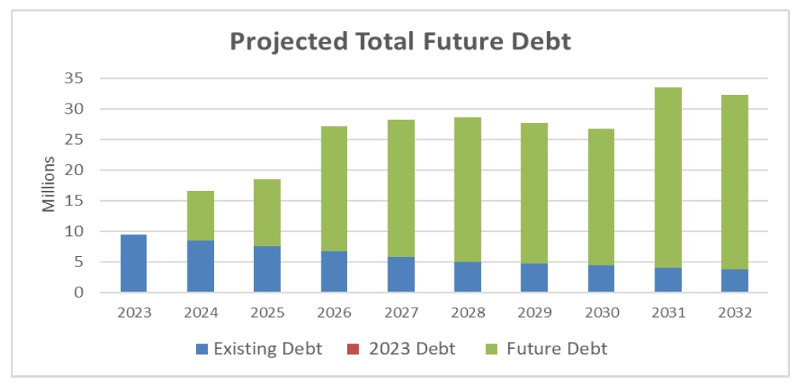After several years of debt reduction and replenishing of municipal reserves, Meaford’s long term debt is inching upward, and is expected to increase significantly in the coming years, in large part due to a much needed wastewater treatment plant expansion along with other critical infrastructure needs.
After exceeding $10 million in 2010, consecutive terms of council had committed to not taking on new debt, and by the end of 2020 Meaford’s debt had been reduced to roughly $5 million. Over the past few years, the municipality’s long term debt has been on the rise, including funding for the new library, and by the end of 2023, municipal long term debt was approaching $10 million, as was shown in an annual long term debt update provided to council this week.
“There have been a number of projects recently that have been debt financed, however overall the debt has remained relatively low. There are however a number of large projects in the future which will potentially result in large debt projects,” Meaford Treasurer Valerie Manning warned in her report to council.
As of the end of 2023, tax-supported long term debt ($3.2 million) accounted for just one third of the overall debt-load, with user pay (water, wastewater, etc.), and development charge supported debt accounting for more than $6 million of the total debt being carried by the municipality.
While municipal debt has been inching upward in recent years, so have municipal investment funds, which as of the end of 2023 are nearly $30 million, roughly three times the total long term debt being carried by the municipality.
The Treasurer’s report warns, however, that a significant increase to the municipal long term debt is expected in the coming years, with a projection of more than $30 million in total debt by 2031, though it could rise even higher. The report notes that additional debt in excess of $17 million is expected to be taken on for bridge reconstruction and rehabilitation projects between 2024 and 2033. Further, the report warns that, “It is expected that the Wastewater Treatment Plant expansion will require significant debt financing with an estimated $46M over the next 10 years.”
“Our other problem is that for the wastewater treatment plant, we are going to be pretty much using our whole debt payment limit for that,” Manning told council on Monday.
As noted in the Treasurer’s report to council, in Ontario, municipalities can incur long-term debt for municipal infrastructure as long as the annual debt repayments do not exceed 25 percent of net revenues.
“The Municipality of Meaford’s 2023 ARL statement illustrates that the Municipality is utilizing 3.61% ($977K/$27M) of net revenues to service debt and is only utilizing 17.17% ($977K/$5.69M) of the legislated capacity of net revenues,” Manning noted in her report.
Members of council expressed concern about the significant increase in municipal debt that is projected, while at the same time accepting that it will almost certainly have to be done.
“It’s a very scary chart into the future,” Councillor Tony Bell noted.
Bell encouraged members of council who will be attending this year’s AMO (Association of Municipalities of Ontario) conference to plead with provincial government leaders for increased municipal infrastructure funding.
“I’m not able to go to AMO this year, but I know many of you on council are. I hope that you have already arranged for a meeting with a Minister. We’re not alone,” Bell told council, noting recent news reports of other municipalities in the province struggling with infrastructure funding.
Bell also noted the progress made by the municipality since 2010, when under order from the province, municipal reserves had to be depleted in order to pay off years of accumulated deficits, which was followed by nearly five years of significant rate increases for Meaford’s ratepayers. The municipal debt load at the end of 2023 is less than it was in 2010, and as opposed to the depleted reserves in 2010, today the municipality has nearly $30 million in the bank.
“This municipality, from a historical note, dug itself out of a bad place in 2010, and that council of that day, 2010 to 2014 was a very brave council, and they levied some pretty heavy taxation to the residents, and dug us out of a dark place. So we have done a lot better on that, and we’ve all contributed to making it better,” Bell told council. “But what’s facing us in the future, we’ve all received reports in the past about the state of the infrastructure, bridges and roads, and how many millions of dollars a year we really should be putting into that.”
Since 2014, council has committed to an annual increase of one percent each for roads and bridges, along with a half-percent increase for municipal facilities, which has allowed the municipality to rebuild reserve funds along with significantly increasing the amount of annual infrastructure rehabilitation that could be undertaken.
“We had financial problems, there’s no doubt about it,” Councillor Harley Greenfield told council. “And we imposed very heavy taxes on our residents, and that was a very bitter pill for all of us to swallow. But, we have had predicted growth for a couple of decades really, and it’s happening, and there will be more. We know that wastewater treatment plant has to be expanded, rebuilt and expanded. Yes, it’s going to be a challenge, but that’s a challenge we have to meet.”
The required expansion of the wastewater treatment plant, on the other hand, is the largest single infrastructure project facing the municipality, and the cost will be in the tens of millions of dollars. While the debt required for the wastewater treatment plant expansion will largely be repaid through development charges, and not current Meaford ratepayers, it will use most if not all of the municipality’s available debt capacity, which could cripple future councils’ ability to address other infrastructure needs.
Expansion of the wastewater treatment plant is expected to take four to five years, once funding sources are secured and a decision is made to move forward.












